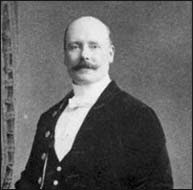On June 5th of 1883, snow fell on New Orleans. It could no longer be denied that nature had failed America and winter had simply never gone away.
This was the beginning of the 'long winter', a mini ice age which would last almost 2 years in much of the northern hemisphere. Volcanic ash from a partial eruption believed to have taken place in Alaska spread across most of the continent in a hazy band that blocked out the sun. Noon was scarcely distinguishable from dawn and temperatures rarely climbed above the 50's. At night it was said that "a pail of water left on the porch would freeze solid by morning."
The impact on American society was deep and broad. Most crops failed. By September of 1883, grain prices were up over 500% versus the previous year. The only cereal grain to be consistently harvested was rye, which had been planted on less than 4% of all United States land in agricultural use. Settlers in the mid-west hitched their wagons up in droves and headed back east, often on the same Oregon Trail that they or their parents had gone west on.
With neither grain nor cattle to trade in, (which had mostly either starved or been slaughtered for lack of feed) Chicago became a virtual ghost town. The capital of the American west was reduced to stops by only a single train, twice weekly. Amazingly, construction continued on the world's first skyscraper. Most of the materials had already been purchased and even when there was no money to pay the workers they continued to show up for duty since there was literally no other work available.
Many of those farmers who remained would soon starve during the famine which occurred between autumn of 1883 and March of 1884. The acute stage of the famine ended when President Chester Arthur finally gave in to popular demand by agreeing to borrow money in order to purchase foreign grain to distribute for free in the areas that were worst hit. Funds were allocated in February and food aid was shipped west beginning early March. Arthur's National Recovery Office also distributed seed and information on how to plant rye as a new crop that would be more likely to survive the regular nightly freezes.
Potatoes, cabbages and rye quickly became the staple foods of not only the mid-west but also the urban centers on the east coast. At first international shipping had boomed as a result of the famine. Merchant ships brought large cargoes of foreign grain for a hungry nation that could no longer feed its self. But the money for such expensive imports disappeared after a boom of roughly 6 months. Americans began looking for new types of food that could be produced closer to home for less money.
Cabbages were planted everywhere. The plant's hardy resistance to cold made it an obvious choice for growing emergency food. Horses were slaughtered in order to use their pastures for cabbage fields. People grew cabbages in front gardens, along roadsides and on any patch of dirt available. Including the lawn in front of the US Capitol in Washington DC.
Deeply in debt and with a population reduced by 15%, America finally emerged from 'The Long Winter' in the spring of 1885. As suddenly as it had come, the dust and ash from the distant volcano disappeared. This resulted in a brief famine of its own, because of the failure of the cold weather dependent crops that American farmers and households had switched to. It would be years before the country returned to anything like normalcy and the federal debt taken on to feed the public only snowballed, arguably leading to the economic upheaval that would follow in the late 1880's.
Friday, June 26, 2009
Subscribe to:
Post Comments (Atom)

You need a correction - President Arthurs NRO did not distribute grain for free. Technically the government of each state where aid was distributed took on a debt to the federal government for those costs. Even though the debts were later forgiven by Congress, it is inaccurate to say that Arthur was giving out food for free. It wasn't intended as socialism.
ReplyDeletewouldn't it be accurate to say that the eruption of Krakatau in August of 1883 also had something to do with the weather in the United States?
ReplyDeleteThe Icelandic volcano erupted 1883 which contributed to this weather
ReplyDeleteAlso, the 1883 eruption of Krakatoa began in May 1883 and culminated with the destruction of Krakatoa on 27 August 1883, spreading ash around the globe.
ReplyDeleteIt is reported that there were 6 foot snow drifts in Orange, Texas in 1885. The bay known as Sabine Lake iced over. Today snow is rare in Southeast Texas.
ReplyDeleteI think mimicking popular posts on other blogs is one of the best ways to get a good idea which will be popular.Such a lovely blog you have shared here with us. Really nice .
ReplyDelete---------------------
Beauty Tips That Save You Money
a fantastic readwhy not try here weblinkYour Domain Name this websitenavigate to this website
ReplyDeleteSmm panel
ReplyDeleteSMM PANEL
iş ilanları
İNSTAGRAM TAKİPÇİ SATIN AL
hirdavatciburada.com
Www.beyazesyateknikservisi.com.tr
servis
tiktok jeton hilesi
cliquez pour plus d'informations Louis Vuitton Dolabuy parcourez ici portefeuilles de répliques cliquez sur la référence jetez un œil sur ce site Web
ReplyDeleteSuccess Write content success. Thanks.
ReplyDeletebetmatik
kıbrıs bahis siteleri
betturkey
betpark
canlı poker siteleri
deneme bonusu
canlı slot siteleri
Good content. You write beautiful things.
ReplyDeletemrbahis
korsan taksi
mrbahis
vbet
sportsbet
hacklink
vbet
taksi
sportsbet
kütahya
ReplyDeletesivas
trabzon
artvin
hatay
GREMİW
urfa
ReplyDeleteantakya
ısparta
aydın
diyarbakır
JZ2KNA